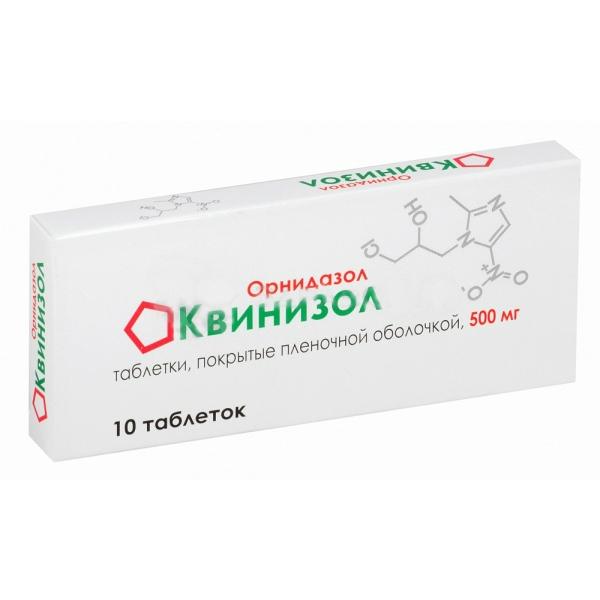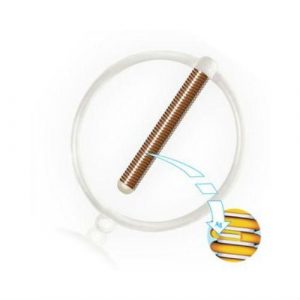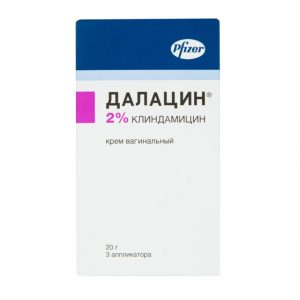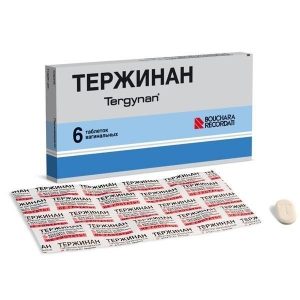Description
Release form
Film-coated tablets
Pharmacological action
Tablets Quinisole is an antiprotozoal and antimicrobial drug derived from 5-nitroimidazole.
The mechanism of action is the biochemical reduction of the 5-nitro group of ornidazole by intracellular transport proteins of anaerobic microorganisms and protozoa.
The reduced 5-nitro group of ornidazole interacts with the DNA of microorganism cells, inhibiting the synthesis of their nucleic acids, which leads to the death of bacteria.
Indications
Trichomoniasis (genitourinary infections in women and men caused by Trichomonas vaginalis), amoebiasis (all intestinal infections, caused by Entamoeba histolica, including amoebic dysentery, and all intestinal forms of amoebiasis, especially amoebic liver abscess), giardiasis.
Prevention of anaerobic infections in colon surgery and gynecological interventions.
Contraindications
hypersensitivity to ornidazole, excipients and other nitroimidazole derivatives, children under 3 years old, and body weight less than 20 kg, I trimester of pregnancy, period of breastfeeding, organic diseases of the central nervous system, pathological changes in blood and abnormalities of blood cells.
With caution Impaired liver function, alcoholism, elderly patients, pregnancy II and III trimester, children over 3 years old and weighing more than 20 kg, elderly patients.
Use during pregnancy and lactation
Ornidazole is contraindicated for use in the first trimester of pregnancy and during breastfeeding.
In an experiment, ornidazole has no teratogenic or toxic effects on the fetus.
Since controlled studies in pregnant women have not been conducted, the use of ornidazole in the second and third trimesters of pregnancy is possible only on absolute indications, when the possible benefits of its use for the mother outweigh the potential risk to the fetus.
If you need to use the drug during breastfeeding, you should stop breastfeeding.
Resumption of breastfeeding is possible no earlier than 48 hours after taking the last dose of the drug.
Composition of
One tablet contains:
Active ingredient:
ornidazole – 500.0 mg.
Excipients (core):
microcrystalline cellulose 35.0 mg,
starch 45.0 mg, croscarmellose sodium
10.0 mg, trd talc
6.0 mg, magnesium mg
stearate 3.0 mg.
Excipients (shell):
hypromellose 10.12 mg,
macrogol 1.0125 mg.
talcum powder 8.0 mg,
titanium dioscide 2.0 mg.
Dosage and administration
Take orally after a meal with plenty of water. Trichomoniasis Adults and children weighing more than 35 kg, 1 tablet 2 times a day (morning and evening) for 5 days.
To eliminate the possibility of reinfection, the sexual partner must always receive the same course of treatment. The daily dose for children weighing 20-35 kg is 25 mg / kg of body weight and is prescribed in one dose, for 5 days. Amoebiasis Treatment regimens: a three-day course of treatment for patients with amoebic dysentery and a 5-10 day course of treatment for all forms of amoebiasis.
Duration of treatment is 3 days. Adults and children weighing more than 35 kg – 3 tablets in one dose in the evening. With a body weight of more than 60 kg – 4 tablets (2 tablets in the morning and evening). Children over 3 years old and with a body weight of 20-35 kg – 40 mg / kg of body weight in one go. The duration of treatment is 5-10 days. Adults and children weighing more than 35 kg – 2 tablets (1 tablet in the morning and evening). Children over 3 years old and with a body weight of 20-35 kg – 25 mg / kg of body weight in one go. Giardiasis
Adults and children weighing more than 35 kg: 3 tablets once in the evening. Children weighing 20-35 kg: 40 mg / kg once a day. The duration of treatment is 1-2 days. Prevention of anaerobic infection during operations: 0.5-1 g for 1-2 hours before surgery, after surgery – 0.5 g 2 times a day for 3-5 days.
Side effects
Side effects are systematized using the following classification:
Very often (> 1/10) Often (> 1/100 – <1/10) Infrequently (> 1/1000 – <1/100) Rarely (> 1 / 10000 – <1/1000) Very rarely (<1/10000) Disorders of the nervous system: often – headache, drowsiness, fatigue, dizziness, rarely – temporary loss of consciousness, tremor, muscle stiffness, impaired coordination of movement, cramps , sensory or mixed peripheral neuropathy, very rarely – a change in taste. Violation of the blood and lymphatic system: infrequently – inhibition of bone marrow hematopoiesis, neuropathy. Disturbance from the digestive system: very often – nausea, vomiting, metallic taste in the mouth, rarely – diarrhea, changes in the activity of “liver” enzymes, loss of appetite. Impaired immune system: infrequently – hypersensitivity reactions, skin rash, itching, urticaria, Quincke edema. active substance Ornidazole Terms of delivery from pharmacies Prescription dosage form tablets




